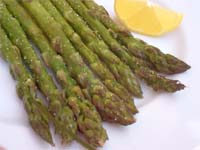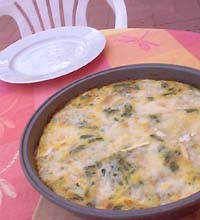Daffodils. Cherry blossoms. Easter bunnies. Asparagus. What do these have in common? Signs of spring!
Here in the NW we have to live through a long, wet winter, but the cold damp days are worth it when spring finally flings itself upon the trees and gardens. As I write, I am being showered with cherry blossom petals, and a golden carpet of daffodils nods in agreement with every statement I make. I love spring – especially when it is in such a good mood.
Oh the pleasures of spring. The sight of new grass, the sound of frogs in the pond, the scent of blossoms, the warmth of sunshine, and best of all, the tastes. Even on a cool cloudy day, asparagus, a traditional veggie on many Easter and Passover tables, says spring. And just like spring, it’s gone all too soon.
Asparagus is a perennial plant that grows from a long horizontal-creeping root, which shoots up numerous asparagus spears for about 7 weeks each year. Asparagus comes in several sizes, from thinner than a pencil to an inch or so thick. The thinner spears come from very young asparagus plants, while the fatter spears shoot from older plants. If the asparagus stalks are left to mature, they bloom into wide bushy ferns.
In the United States, green asparagus are the most commonly available. However, in Europe, white asparagus, grown completely underground in order to maintain its white color, is preferred. The root is planted in deep trenches and as the stalks begin to grow. They are kept completely covered with straw and dirt to prevent sunlight from triggering the green chlorophyll in the plant.
The other day, while whining to my checkout lady about the price of a pound of organic asparagus, I learned that wild asparagus used to be very common here. She informed me that as a kid she used to go to the creek beds with her mother to pick their own asparagus for dinner. Can’t beat that price and talk about eating locally!Wet Feet, Good to Eat
Asparagus is best when simply prepared, you want to be sure that you choose the best quality when shopping. Naturally, you’ll want to avoid any asparagus that looks mottled and discolored, or has a musty sort of smell. It’s also important to look for vendors who store their asparagus in water. When left out in the produce  section without it, the asparagus will lose much of its flavor. In many ways, asparagus is closer to a flower than a vegetable. When you get your stalks home, the best way to keep them fresh is to cut a ¼ inch off the bottoms, then store them in a jar of water. At the very least, wrap the ends in a wet paper towel.
section without it, the asparagus will lose much of its flavor. In many ways, asparagus is closer to a flower than a vegetable. When you get your stalks home, the best way to keep them fresh is to cut a ¼ inch off the bottoms, then store them in a jar of water. At the very least, wrap the ends in a wet paper towel.
Preparing Asparagus
Asparagus are very simple to prepare, but the method you use will depend on the size of the stalk. Thin spears only need to have the very ends snipped off with a vegetable knife before cooking. The ends of larger asparagus spears tend to be very woody. To make them taste their best, you will need to snap off or peel the ends. Snapping off the ends is a little wasteful, but much quicker than peeling. To snap off the tough portion of the asparagus, grasp the stalk with both hands and bend the bottom portion until it breaks off. The asparagus will break at the point where the tender portion ends and the tough part begins. If, on the other hand, you prefer to peel, a vegetable peeler makes the job much easier. Peel about two inches up the stalk.
Enough facts! It’s time to get to the good part -- eating asparagus! In a way, it was a struggle to come up with recipes for this article because my favorite way to eat asparagus is so simple that it’s hard to call it a recipe. There’s nothing I love more than barely cooked asparagus dipped in mayo. Just like that; everyday for a week would make me happy.
Asparagus are delicious almost any way you cook them: steamed, boiled, sautéed, baked, or micro-waved. The key to great asparagus is to avoid overcooking. For slender stalks, a few minutes in boiling water, the sauté pan, or the microwave should do. Just keep an eye on them. Nothing ruins asparagus more than cooking them until they are a grayish wilted mess.
The easiest way to cook asparagus, in my humble opinion, is to lay the stalks in a microwave proof dish, large enough for them to lay flat. Then, add about a ½ cup water and microwave for 3-4 minutes. I like mine pretty crunchy, so you may want to add another minute or two if you like yours softer. Drain and eat! Dipping them in mayo or melted better is easy and tasty, but so is drizzle of olive oil and lemon, or a drizzle of hollandaise sauce, or a sprinkle of soy and sesame oil. Fresh squeezed lemon, salt and a liberal sprinkling of pepper. Ahh, there are so many ways to enjoy asparagus that I get hungry just thinking about it. Here are two more great ways to use asparagus …
o o o
I love roasted vegetables! I just discovered how easy it is to roast asparagus. They are so delicious that I have fixed this recipe three times this week! So far they’ve proven to be the perfect accompaniment for pizza, roast chicken and, well, steamed asparagus. Hey, they’re only around for a few weeks each year!
 Roasted Asparagus
Roasted Asparagus
1 pound asparagus
2 Tablespoon Olive Oil
Salt
Heat the oven to 400 degrees. Drizzle a cookie sheet with the oil. Add asparagus and roll them around until they are coated in oil. Put into a hot oven for 6-10 minutes, depending on the thickness of the asparagus. When they get a slightly mottled appearance, remove from the oven and immediately sprinkle with salt. Let them sit for a few minutes before serving.
This is a great fast dinner. Whip this up and serve with French bread and a big salad. Then take it outside to enjoy the longer evenings, or at least open a window.
Asparagus and Brie Frittata
2 cups cut asparagus
4 green onions, chopped
1-Tablespoon butter
6 eggs
½ teaspoon salt
1/3 cup Milk
½ cup Brie or sliced Munster cheese
 Preheat oven to 400 degrees. Over medium high heat melt butter and sauté asparagus and green onions until tender, about 4 minutes. Meanwhile whisk eggs, salt and milk together. Pour the egg mixture into a buttered 9x9-baking dish (or similar-sized oven-proof container) and top with asparagus mixture. Bake 5 minutes.
Preheat oven to 400 degrees. Over medium high heat melt butter and sauté asparagus and green onions until tender, about 4 minutes. Meanwhile whisk eggs, salt and milk together. Pour the egg mixture into a buttered 9x9-baking dish (or similar-sized oven-proof container) and top with asparagus mixture. Bake 5 minutes.
Remove from oven and top with cheese. You can’t really spread Brie, so just dollop it evenly over the eggs. Put it back in the oven for about another 5-7 minutes. It is ready to come out of the oven with the eggs are set, and the cheese melted and a little toasted on the edges.
No comments:
Post a Comment